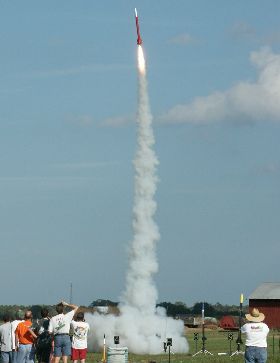Sport Rocketry Hobbyists have been building and launching model rockets since G. Harry Stine and Orville Carlisle developed the first model rocket motors in the late 1950s. Hobbyists have been building and launching model rockets since G. Harry Stine and Orville Carlisle developed the first model rocket motors in the late 1950s.
Shortly after the launch of Sputnik in 1957, amateur rocketeers began building their own rockets - sometimes with disastrous results. Stine, an engineer at White Sands Proving Grounds, wrote an article for Popular Mechanics magazine asking what could be done to prevent kids from hurting themselves trying to build their own rocket motors. Carlisle provided the answer. Carlisle sent Stine a package containing a few small rocket motors. He described how these motors could be commercially manufactured and used to launch homebuilt rockets safely. Stine formed Model Missiles, Inc. which sold motors manufactured by Carlisle as well as kits such as The Rock-A-Chute. Carlisle was not able to keep up with the demand for motors, so Stine turned to Vernon Estes. Estes had experience in manufacturing and created an automated process for making rocket motors. Estes formed Estes Industries which is now the largest manufacturer of model rocket motors and kits.
The model rocket motor is ignited electrically. As the propellant burns, hot gases rush out of the nozzle propelling the rocket in the opposite direction. After the propellant is exhausted, the delay element begins burning. The delay element produces more smoke and less thrust than the propellant. This allows the rocket to coast to its maximum altitude before the ejection charge is ignited. The ejection charge bursts through the retainer cap pressurizing the rocket's body tube to deploy the recovery device (usually a parachute). |
 It's the pre-made rocket motor that makes
It's the pre-made rocket motor that makes